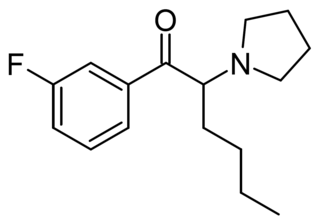
α-Pyrrolidinopentiophenone is a synthetic stimulant of the cathinone class developed in the 1960s that has been sold as a designer drug. Colloquially, it is sometimes called flakka. α-PVP is chemically related to pyrovalerone and is the ketone analog of prolintane.

α-Pyrrolidinohexiophenone is a synthetic stimulant drug of the cathinone class developed in the 1960s which has been reported as a novel designer drug.

4'-Methoxy-α-pyrrolidinopentiophenone is a stimulant drug of the cathinone class that has been sold online as a designer drug.

3',4'-Dimethoxy-α-pyrrolidinopentiophenone is a synthetic stimulant drug of the cathinone class that has been sold online as a designer drug. It is a relatively weak inhibitor of serotonin reuptake and has little affinity in vitro for dopamine or noradrenaline transporters.

4'-Fluoro-α-pyrrolidinooctanophenone is a stimulant drug of the cathinone class which has been reported as a novel designer drug.

4'-Fluoro-α-pyrrolidinopentiophenone is a stimulant drug of the cathinone class which has been reported as a novel designer drug.

5-DBFPV is a stimulant of the cathinone class that has been sold online as a designer drug. It is an analogue of MDPV where the methylenedioxyphenyl group has been replaced by dihydrobenzofuran.

4-Chloro-alpha-pyrrolidinovalerophenone is an emerging recreational designer drug of the pyrrolidinophenone class, similar in structure to alpha-pyrrolidinopentiophenone (α-PVP). The pharmacology and toxicity of this compound is unknown, though it is presumed to be a stimulant drug.

N-Ethylhexedrone (also known as α-ethylaminocaprophenone, N-ethylnorhexedrone, hexen, and NEH) is a stimulant of the cathinone class that acts as a norepinephrine–dopamine reuptake inhibitor (NDRI) with IC50 values of 0.0978 and 0.0467 μM, respectively. N-Ethylhexedrone was first mentioned in a series of patents by Boehringer Ingelheim in the 1960s which led to the development of the better-known drug methylenedioxypyrovalerone (MDPV). Since the mid-2010s, N-ethylhexedrone has been sold online as a designer drug. In 2018, N-ethylhexedrone was the second most common drug of the cathinone class to be identified in Drug Enforcement Administration seizures.

Hexedrone is a stimulant of the substituted cathinone class which has been sold as a designer drug. Through analysis of the Structure-Activity Relationships in similar cathinones such as MDPV, Hexedrone is believed to be a norepinephrine–dopamine reuptake inhibitor.

MDPHP (3',4'-Methylenedioxy-α-pyrrolidinohexiophenone) is a stimulant of the cathinone class originally developed in the 1960s, which has been reported as a novel designer drug. In the UK its slang name is monkey dust. It is closely related to the potent stimulant MDPV though with slightly milder effects, and has been used as an alternative in some countries following the banning of MDPV.

α-Pyrrolidinoheptaphenone is a designer drug of the pyrrolidinophenone class of cathinones. It is the higher homolog of α-pyrrolidinohexiophenone (α-PHP).

4-Methyl-α-ethylaminopentiophenone (4-MEAP) is a designer drug of the cathinone class. It is a higher homolog of 4-methylpentedrone (4-MPD) with an ethyl group in place of the methyl group. 4-MEAP has been found in samples of drugs sold as 4-MPD.

α-PCyP is a stimulant drug of the cathinone class that has been sold online as a designer drug. In a series of alpha-substituted pyrrolidinyl cathinone derivatives developed in 2015, the alpha-cyclopentyl derivative was found to have around the same potency in vitro as an inhibitor of the dopamine transporter as the alpha-propyl derivative α-PVP, while the alpha-cyclohexyl derivative α-PCyP was around twice as strong.

α-PHiP, is a stimulant drug of the cathinone class that has been sold online as a designer drug. It is a positional isomer of pyrovalerone, with the methyl group shifted from the 4-position of the aromatic ring to the 4-position of the acyl chain. In a classic 2006 study of pyrrolidinyl cathinone derivatives by Meltzer et al. at Organix, the alpha-isobutyl derivative of pyrovalerone, O-2494, was found to have the highest potency in vitro as an inhibitor of the dopamine transporter of the alpha substituted derivatives tested; however, it was not until ten years later in July 2016 that α-PHiP was first identified as a designer drug, when it was reported to the EMCDDA by a forensic laboratory in Slovenia.

3-Fluoro-α-Pyrrolidinovalerophenone (3F-PVP) is a recreational designer drug from the substituted cathinone family with stimulant effects, which first appeared on the illicit market in around 2018. It is illegal in Finland.

MFPVP (3-Methyl-4-fluoro-α-pyrrolidinovalerophenone) is a recreational designer drug from the substituted cathinone family, with stimulant effects. It was first identified in Sweden in April 2020 and was among the most widely encountered substituted cathinone derivatives in 2021, though it since appears to have declined in prevalence.

4-Fluoro-alpha-PHP (4F-PHP) is a recreational designer drug from the substituted cathinone family with stimulant effects, which first appeared on the illicit market in around 2017.

3-Fluoro-alpha-PHP (3F-PHP) is a substituted cathinone derivative with stimulant effects which has been sold as a designer drug. It was first identified in Sweden in 2020 and continues to be detected in seized drug samples, though it appears to have been less widely used than related compounds such as 3F-PVP and 3F-PiHP.



















